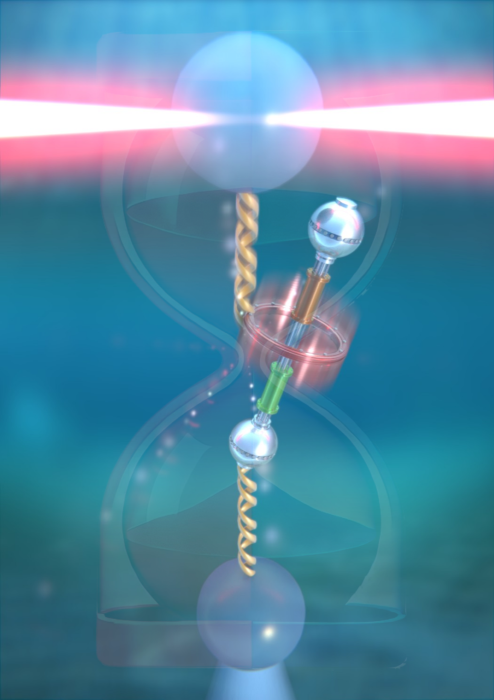In molecular shuttles, a ring molecule is threaded onto a linear molecular strand and can move between two portions of the strand, called stations, in response to external stimuli. Chemical stimulus, light or mechanical force determine the time the shuttle spends at each station while it hops back and forth by random thermal motion. Measuring individual trajectories during the operation of such synthetic devices is crucial for a thorough understanding of its operation and in the optimization of molecular machines.
 The molecular shuttle is attached to two polystyrene beads through two DNA molecules. The hourglass symbolizes the symmetric trajectories of the shuttle. Credit: Scixel/IMDEA Nanociencia.
The molecular shuttle is attached to two polystyrene beads through two DNA molecules. The hourglass symbolizes the symmetric trajectories of the shuttle. Credit: Scixel/IMDEA Nanociencia.
Researchers at IMDEA Nanociencia, led by Emilio Pérez and Borja Ibarra, have used optical tweezers to measure the individual transition paths of molecular shuttles between two stations under mechanical equilibrium. Their results showed that the transition-path times present wide distributions while maintaining a time-reversal symmetry. In collaboration with Prof. Raymond Astumian (University of Maine, US), they confirmed experimentally that the transition paths times show symmetry, that is the shuttle does take the same time going up through the energy profile as it does going down.
The data analysis showed that the mean values of transitions are identical, showing similar shapes for the forward and reverse reactions. The shuttle spends the same time in each step between the two stations, independently on the direction of the shift. This symmetry of the transition-path time distributions was confirmed in accordance to the principle of microscopic reversibility.
Microscopic reversibility states that, at the molecular level, every process and its reverse occur with the same probability in equilibrium. It is a very well established principle in statistical mechanics, but it is hard to measure experimentally, as it involves tracking the trajectories of individual molecules.
Molecular shuttling involves passage through a high-energy transition state forming an energy barrier between stable states. The properties of the transition paths through these states contain all the fundamental mechanistic information about the shuttling process. Up to date, transition paths have been studied theoretically, but their short lifetimes in the order of milliseconds, as well as their intrinsic stochastic nature have prevented their direct observation experimentally until now. The results reported here provide a first experimental look at the principle of microscopic reversibility in molecular shuttles.
The study paves the way for a detailed and quantitative understanding of the dynamics of synthetic molecular machines. This is possible due to the extreme resolution and sensibility of the experimental setup. Optical tweezers have the capability of measuring and controlling precisely molecular devices in the range of forces of picoNewton. Back in 2018, researchers Pérez and Ibarra followed during 5 full minutes the position of a molecular shuttle. Then, they focused on how much time the shuttle spent on each station. Now, they focus on the journey, giving a thorough analysis of the transition paths, the full trajectory –position vs. time- of the molecule, extracting the energy profile along the thread.
The field of molecular shuttles is of relevance to nanotechnology in its quest for nanoscale electronic components and also to biology where many biological functions are based on molecular shuttles. This study has been performed in water, an advantage that pushes forward the possibility of using this devices for biotechnological applications. The examples of molecular machines are many: programmable molecular switches and sensors, nanovalves for drug-delivery systems, adaptive biomaterials, molecular muscles, etcetera. The Nobel Prize in Chemistry to Feringa, Sauvage and Stoddart already recognized in 2016 that there is an enormous potential in the development of molecular machines.
The research, recently published in the journal Chem (DOI: 10.1016/j.chempr.2024.102410) paves the way to explore the temporal sequence of events during shuttling and investigate the possibility of taking multiple paths through the energy landscape. The information uncovered by this study will guide the rational design of efficient molecular switches and motors with a tailored response, for applications in nanotechnology and biomedicine.
This work is a collaboration among the groups at IMDEA Nanociencia “Chemistry of Low-Dimensional Materials” led by Emilio M. Pérez and “Molecular Motors Manipulation” led by Borja Ibarra, and Raymond Astumian (Maine University, US), and has been partially funded by the accreditation Excellence Severo Ochoa awarded to IMDEA Nanociencia (CEX2020-001039-S).